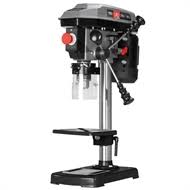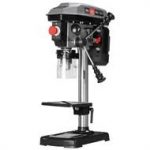Last Updated on June 24, 2021 by James
A drill press is used for boring or drilling holes in wood, metals, or similar surfaces. It has a chuck, a kind of clamp on one end. This chuck holds the rotating cylindrical tool used to make the holes. Drill press is generally used in construction, carpentry and other woodworks. It is typically used by professionals working in the aforementioned fields. If you are using a drill press for a DIY task, you must exercise caution to avoid any mishap.
Here are 10 safety precautions to take when using a drill press:
- Help Yourself With Safety Goggles and Guards.
The primary thing that you must do before starting with a drill press is read the instruction manual carefully. This will ensure that you are on the right track. After you are done with that, you must keep all the safety guards within reach. These necessarily include a face shield and a pair of safety goggles. In addition, wear hearing and side shields.
- Clear Your Drilling Space Before Starting.
Drill press is heavy to handle. Starting it without clearing the workspace can lead to dire consequences. They may even harm other things in sight. Therefore, it is always advised to keep the table clear and have nothing but the object that needs to be drilled. Once you’re through with that, you may start the machine.
- Exercise Caution: Especially With Your Fingers.
Drill, if not used cautiously, can leave you wounded. To avoid that from happening, follow the instructions properly. It is advised that you keep your fingers no less than 3 inches away from the rotating tool. Following this will guarantee safety.
- Prevent Your Clothes Or Hair From Getting Caught In The Process.
It is advised that you secure your hair using a hair net and avoid wearing any loose clothes or other accessories that may get caught in the drilling press.
- Ensure the Rotating Tool Is Secured Properly In the Clamp.
This is an important safety measure. If you do not guarantee that the rotating instrument is correctly locked in the clamp, the instrument may waiver. This may cause disruption in the drilling process and hence, you may end up getting injured.
- Work Both Firmly And Gently With the Drill Press.
Because of the hefty build of the machine, amateur users tend to lay the weight of their hands as well as of the machine on the object. This causes the object to break and in turn, leading the machine to drill through your table. A drill press should be held firmly so you would not drop it. However, the chuck should be placed in way that the weight of your hand would not fall on the surface. Professional drill press users follow this technique to get their work neatly done.
- Things That You Must Not Touch During Or After the Drilling Process.
Two drill press parts that you should never touch, because of their riskiness, are,
- The rotating tool that is still spinning or has not stopped spinning after the drilling is done.
- The shave that has dropped immediately after the surface has been drilled, as it is extremely hot.
- Use the Drill Press At the Recommended Speed Only.
Any speed that is higher or lower than the suggested speed is not ideal. Increasing the speed can lead to an uncontrollable drilling device. It can send you straight to the hospital. On the contrary, decreasing the speed may stall the motor of the drill press. Hence, read the recommended speed in the instruction manual and look to follow it meticulously.
- Work in an airy room for further safety.
You may have experienced suffocation or difficulty in breathing when you are in woodworking zone. This is because many people do not use a well-ventilated area while drilling. The shave or sawdust can get mixed with the air and cause suffocation.
- The Dos and Don’ts After Drilling Is Done.
- The machine should carefully be disconnected from the power source before pulling the power plug out.
- Do not use your hands to stop the rotating tool from spinning.
- Do not keep the tool running unsupervised after you are done with it.

